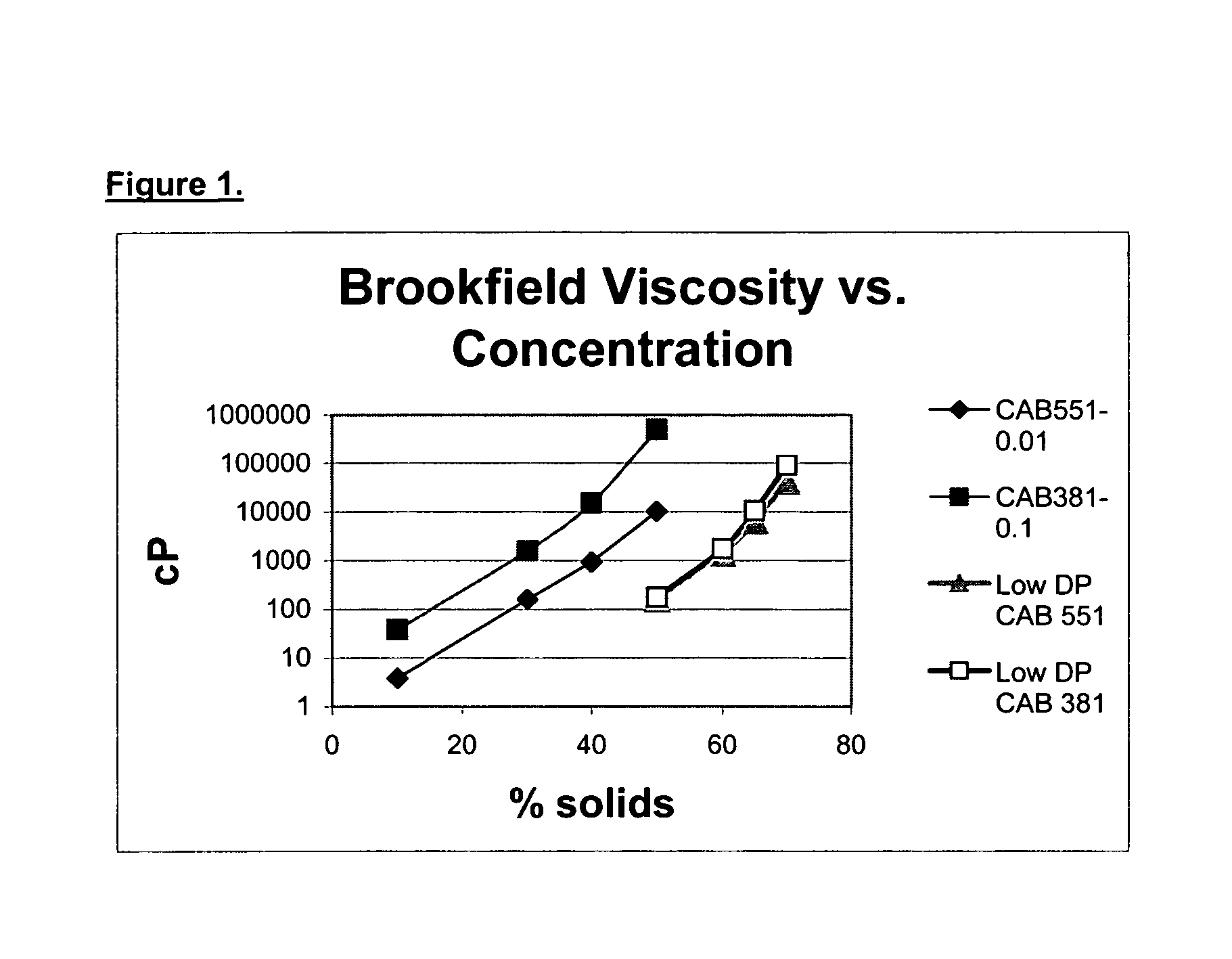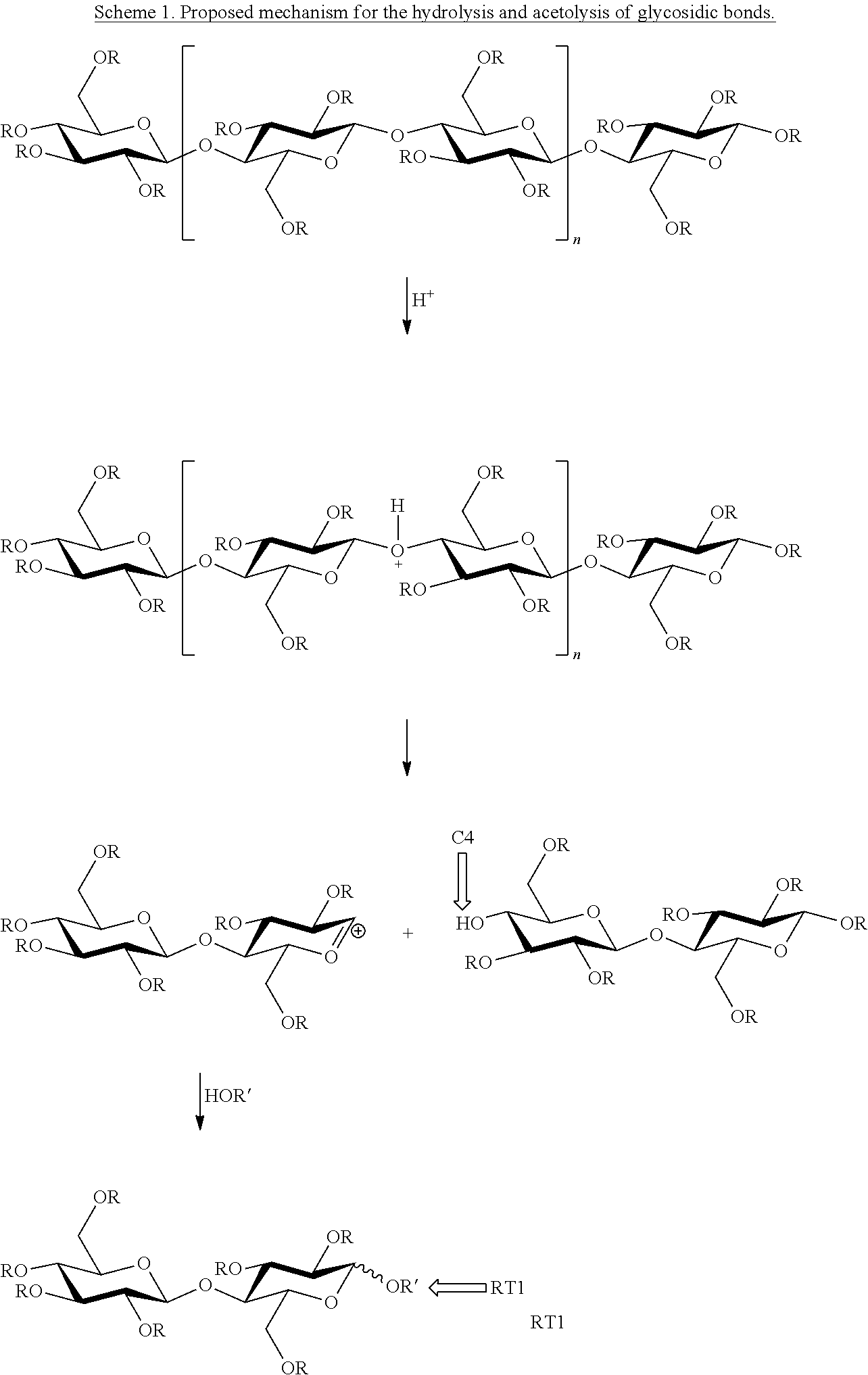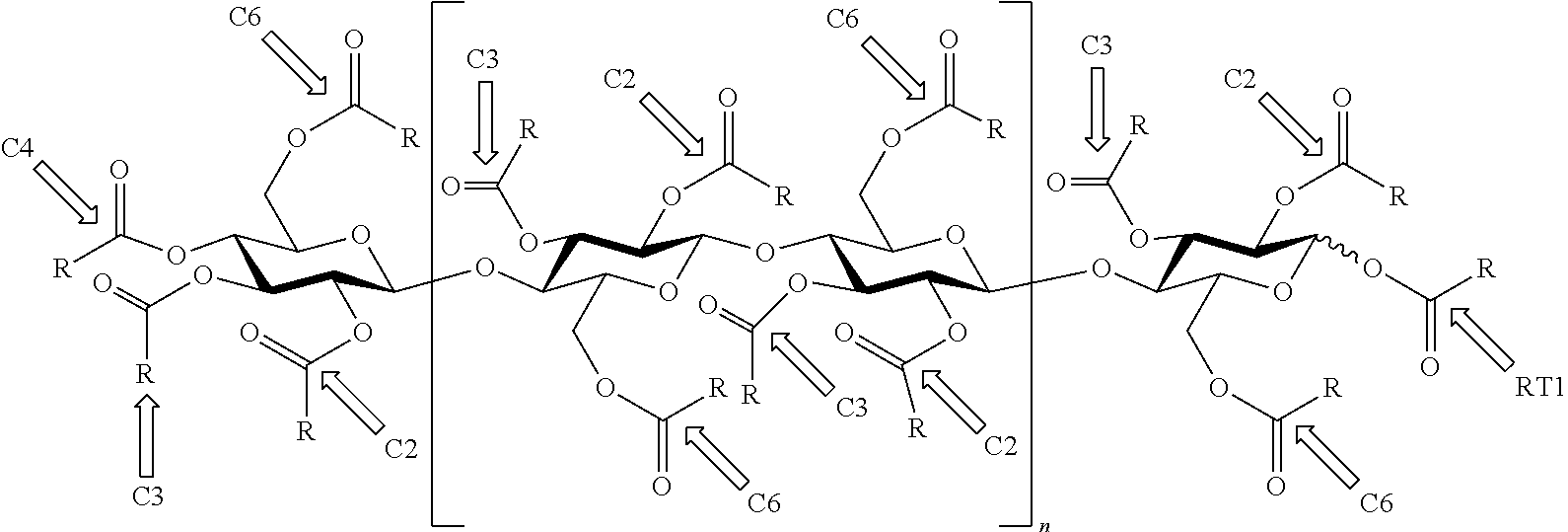Low molecular weight cellulose mixed esters and their use as low viscosity binders and modifiers in coating compositions
a technology of cellulose and esters, which is applied in the field of cellulose chemistry, can solve the problems of loss of molecular weight, degradation of cellulose, poor plastic properties and brittle films, etc., and achieves the effects of low molecular weight, high maximum degree of substitution, and high solids
- Summary
- Abstract
- Description
- Claims
- Application Information
AI Technical Summary
Benefits of technology
Problems solved by technology
Method used
Image
Examples
example 1
Preparation of a Mid-Butyryl Cellulose Ester (HS-CAB-38) According to the Invention
[0185]Cellulose (80 g), provided as a dissolving grade of softwood pulp with an α-cellulose content of at least 94%, was activated by soaking in water (˜1000 mL) in excess of 20 minutes, and then filtering through a fritted funnel to remove the water. Residual water was removed by washing the water-wet cellulose with acetic acid (˜2000 mL). The acetic acid-wet cellulose was then washed with butyric acid (˜2000 mL). A 2 L-reaction kettle was charged with the butyric acid-wet activated cellulose (311.67 g). Butyric acid (145.8 g) was added to the kettle. The mixture was cooled to 15° C. A mixture of butyric anhydride (225.9 g), acetic anhydride (96.8 g), and sulfuric acid (3.42 g) were cooled to 15° C. and then added to the reaction kettle. The mixture was stirred for 1 hour at room temperature. The mixture was then heated to 84.2° C. and stirred for 11.5 hours. A mixture of water (150 g) and acetic aci...
example 2
Preparation of a Mid-Butyryl Cellulose Ester (HS-CAB-38) According to the Invention
[0186]Cellulose (80 g), provided as a dissolving grade of softwood pulp with an α-cellulose content of at least 94%, was activated by soaking in water (˜1000 mL) for at least 20 minutes and then filtering through a fritted funnel to remove the water. Residual water was removed by washing the water-wet cellulose with acetic acid (˜2000 mL). The acetic acid-wet cellulose was then washed with butyric acid (˜2000 mL). A 2 L-reaction kettle was charged with the butyric acid-wet activated cellulose (415 g). Butyric acid (46.6 g) was added to the kettle. The mixture was cooled to 15° C. A mixture of butyric anhydride (246.4 g), acetic anhydride (98.8 g), and sulfuric acid (3.42 g) were cooled to 15° C. and then added to the reaction kettle. The mixture was stirred for 1 hour at room temperature. The mixture was then heated to 78.3° C. and stirred for 11.2 hours. A mixture of water (156 g) and acetic acid (10...
example 3
Preparation of a High-Butyryl Cellulose Ester (HS-CAB-55) According to the Invention
[0187]Cellulose (80 g), provided as a dissolving grade of softwood pulp with an α-cellulose content of at least 94%, was activated by soaking in water (˜1000 mL) for at least 20 minutes and then filtering through a fritted funnel to remove the water. Residual water was removed by washing the water-wet cellulose with acetic acid (˜2000 mL). The acetic acid-wet cellulose was then washed with butyric acid (˜2000 mL). A 2 L-reaction kettle was charged with the butyric acid-wet activated cellulose (390.33 g). Butyric acid (70.3 g) was added to the kettle. The mixture was cooled to 15° C. A mixture of butyric anhydride (396.1 g), acetic anhydride (0 g), and sulfuric acid (3.24 g) were cooled to 15° C. and then added to the reaction kettle. The mixture was stirred for 1 hour at room temperature. The mixture was then heated to 87.4° C. and stirred for 11.0 hours. A mixture of water (164 g) and acetic acid (1...
PUM
 Login to View More
Login to View More Abstract
Description
Claims
Application Information
 Login to View More
Login to View More - R&D
- Intellectual Property
- Life Sciences
- Materials
- Tech Scout
- Unparalleled Data Quality
- Higher Quality Content
- 60% Fewer Hallucinations
Browse by: Latest US Patents, China's latest patents, Technical Efficacy Thesaurus, Application Domain, Technology Topic, Popular Technical Reports.
© 2025 PatSnap. All rights reserved.Legal|Privacy policy|Modern Slavery Act Transparency Statement|Sitemap|About US| Contact US: help@patsnap.com



